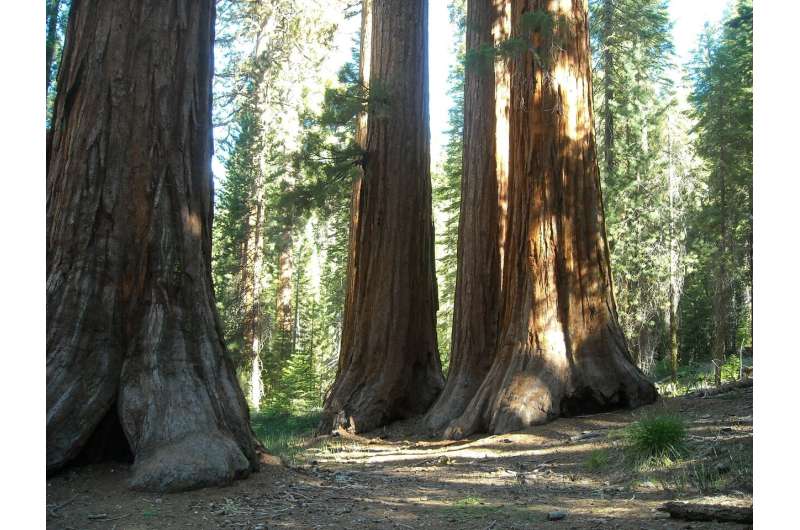
High-intensity fires in 2020 and 2021 devastated the adult sequoia tree population globally, particularly at Sequoia and Kings Canyon National Parks in Northern California.
That is one of the few things that National Park Service staffers and the environmentalists who are suing the agency can agree on.
At the root of the lawsuit, filed earlier this month, is a fundamental disagreement over the role of high-intensity fires. The National Park Service is calling “for action … with some level of urgency” to reseed burned areas that are “otherwise unlikely to recover” without human intervention. They see these fires as a threat to the species.
Research ecologist Chad Hanson, however, insists that such activity is unnecessary and “artificial.” He says high-intensity fires help regrow dying populations by clearing brush that chokes young seedlings. Further, the process of reseeding would entail the use of dynamite and chainsaws, which would damage forest populations.
Hanson’s John Muir Project along with Wilderness Watch, Sequoia ForestKeeper and the Tule River Conservancy filed the suit against the National Park Service to stop the agency’s plan.
The complaint was added as an addendum to a previous lawsuit against the National Park Service intended to stop the thinning of forests to prevent and lessen the severity of fires.
“I’m not exactly sure what’s going on with the National Park Service, but the news coming after the fires is very good,” Hanson said. “The regeneration of the forest is on pace to be the best in decades, but it seems like we’re allergic to good news.”
Hanson first visited burned areas within the Sequoia and Kings Canyon National Parks in late June.
Until that point, the news coming from these areas was gloomy.
A National Park Service report in June 2021 said 10% of the world’s sequoias had been wiped out by the Castle fire alone. Ecologists and researchers with the U.S. Geological Survey, the U.S. Forest Service and other agencies had an estimate that was nearly double that, based on two major fires in 2020 and 2021. They put the loss of the giant trees somewhere between 13% and 19%.
Hanson disputed those figures, saying his on-the-ground surveys coupled with satellite imagery resulted in an estimated sequoia loss of 8% over the same period, from 2020 to 2021.
He says that much of the National Park Service’s data come from “anecdotal sets collected by non-scientists.”
He added that laypeople gathering the data counted trees that had already perished from drought stress and age, and other trees considered dead were still alive.
“They’re well-intentioned, for sure,” Hanson said, “but wrong.”
Sintia Kawasaki-Yee, a parks spokesperson, said she could not talk about the lawsuit. She did, however, strongly push back at the “non-scientific” claim made by Hanson.
“Look at participants involved in the research,” she said. “They’re from USGS, UC Berkeley and various experts in the field of sequoias. This was well-researched.”
The numbers dispute extends to seedlings.
The National Park Service said a reseeding program is needed based on the low average of 14,112 seedlings per acre found the second year after a major fire.
Hanson and other environmentalists in the lawsuit dispute that figure, saying 20,000 to 30,000 seedlings per acre were “typical” at Redwood Mountain Grove, one of six such groves under consideration for reseeding at Sequoia and Kings Canyon parks. Hanson said the counting was done throughout this summer and fall. The other areas include Suwanee, New Oriole Lake, Dillonwood, Board Camp and Homers Nose.
“Sequoia seedlings look like shrubs,” Hanson said, “and at these places that were hard hit by fire, you almost couldn’t avoid stepping on them because they were so abundant.”
He said that, in some areas, the number of seedlings rose as high as 150,000 to 200,000 per acre. He said he pointed that out to Clayton Jordan, superintendent of Sequoia and Kings Canyon National Parks, on a trip to Redwood Mountain Grove in September.
If the lawsuit is successful, it would stop the National Park Service from authorizing the use of dynamite, chainsaws and mule trains to reach remote areas for reseeding.
Sam Hodder, president and chief executive of the Save the Redwoods League conservation organization, said he understood the “emergency” that created the need to reseed.
“We’ve lost 19% of giant sequoias in just two years,” he said. “That alone established a sense of urgency.”
Hodder, who is not associated with the lawsuit, said he would not comment on its merits, but he said he found it “regrettable” that “repeated lawsuits that get dismissed are slowing down the process.”
“We firmly support our public agency partners to advance this work,” he said.
2023 Los Angeles Times. Distributed by Tribune Content Agency, LLC.
The National Park Service wants to plant sequoias: Environmentalists sue, say there’s no need to interfere (2023, November 29)
retrieved 29 November 2023
from https://phys.org/news/2023-11-national-sequoias-environmentalists-sue.html
part may be reproduced without the written permission. The content is provided for information purposes only.